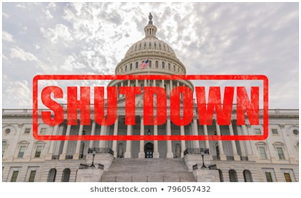Testo e traduzione di Anna Tonioli

The United States has faced the longest shutdown in American history
To build a wall or not to built it, this is the issue that has kept America divided and that has left more than 800,000 people without a pay check for more than a month.
The 45th President of the United States Donald Trump hasn’t changed his mind and didn’t want to stop the shutdown, the reason? He wants to get 5 billion dollars from the Congress to build the wall at the border with Mexico.
Shutdown is the English term which indicates the block of all the administrative actions. This particular process of the American political system happens every time the Congress doesn’t approve a bill. The entire term is government shutdown, it deals with the executive branch and it concerns the fact that in the US the Congress has the exclusive power on the federal budget. This means everyone that all the appropriations that create the public spending, and so the budget law which determines the refinancing of all the administrative activities, has to be approved by each branches of the Congress (Senate and House of Representatives)
Trump has promised to build the wall since his election and he’s convinced that this wall will help to stop people, arms and drugs from South America from coming in the country illegally. Now that a caravan of about 7 thousand people is getting closer and closer to the country’s border the President claims loudly the money to build the wall and to stop them.
The congress, which should allow the bill, is now divided between Democrats and Republicans in fact the House of Representative is controlled by the Democrats and the Senate is controlled by the Republicans. The bill has to pass through by the House of Representatives, before being accepted by the Senate and therefore be used to build the wall. The Democrats are completely against this bill and they don’t want to give to Trump 5 billion dollars for his wall.
The President has decreased his price from 5 to 2.5 billion, but the Democrats are unmovable and Trump was forced to slightly change his plans trying to make a deal with them. For years the Democrats have been dealing with DACA(Deferred Action for Childhood Arrivals), an association which is struggling to allow children, who had been brought illegally in the country when they were kids, to stay in the country and give them a proper USA citizenship. Therefore Trump agreed on letting these children in the country without any fear of being deported, in exchange of the Democrats approval for the 5 billion-dollars bill.
The night of the 25th of January Trump declared the end of the shutdown, started the 21st of December and lasted 35 days.
Donald Trump said that the government is staying opened for other 3 weeks, during the which he will try to find a compromise , but in this right moment no party wants to give up. A situation that afflicts really hard the people who work for the government, who have to keep working without being paid.

Gli Stati Uniti hanno affrontato il più lungo shutdown della storia americana
Costruire un muro o non costruirlo, questo è il problema che sta mantenendo l’America divisa e che ha lascianto oltre 800.000 persone senza stipendio per più di un mese.
Il 45 ° presidente degli Stati Uniti Donald Trump non ha voluto cambiare idea e non voleva concludere lo shutdown, il motivo? Vuole ottenere 5 miliardi di dollari dal Congresso per costruire il muro al confine con il Messico.
Shutdown è il termine inglese con cui si indica il blocco delle attività amministrative. Questa particolare procedura del sistema politico statunitense si verifica ogni volta che il Congresso non riesce ad approvare la legge di bilancio. Il termine esteso è government shutdown, coinvolge il settore esecutivo e riguarda il fatto che negli USA il Congresso esercita un potere esecutivo esclusivo sulla gestione del bilancio federale. Ciò significa che tutti gli stanziamenti che formano la spesa pubblica, e cioè la legge di bilancio che stabilisce il finanziamento delle attività amministrative, deve essere approvata da entrambi i rami del parlamento ( Senato e Camera dei Rappresentati).
Trump ha promesso la costruzione del muro dopo la sua elezione ed è convinto che questo muro aiuterà a fermare i migranti, le armi e le droghe dal Sud America a non entrare illegalmente nel paese. Ora che una carovana di circa 7mila persone si sta avvicinando sempre più al confine del paese, il presidente reclama i soldi per costruire il muro e fermarli.
Il congresso, che dovrebbe accettare la legge, è ora diviso tra democratici e repubblicani, infatti la camera dei rappresentanti è controllata dai democratici e il senato è controllato dai repubblicani. Il disegno di legge prima di essere accettato dal Senato e quindi essere utilizzabile deve passare attraverso la Camera dei Rappresentanti.
I democratici sono completamente contrari a questo disegno di legge e non vogliono concedere a Trump 5 miliardi di dollari per il suo muro. Il presidente ha cambiato il suo prezzo da 5 a 2,5 miliardi, ma i democratici rimangono della loro idea, Trump ha quindi cercato di fare un accordo con loro. Per anni i Democratici hanno avuto a che fare con il DACA (Deferred Action for Childhood Arrivals), un’associazione che vuole lasciare i bambini, che erano stati portati nel paese illegalmente quando erano bambini, rimanere nel paese e dare loro la cittadinanza. Trump ha garantito che se la Camera dei Rapressentati passerà la legge il governo lascierà questi bambini vivere nel paese senza deportarli.
La sera del 25 gennaio Trump ha dichiarato la fine del cosiddetto shutdown, iniziato il 21 dicembre e durato 35 giorni. Donald Trump ha affermato che il governo rimarra aperto per tre settimane, durante le quali si proverà a trovare un compromesso, ma in questo momento nessun partito vuole arrendersi. Una situazione che colpisce duramente le persone che lavorano per il governo, che devono continuare a lavorare senza essere pagati.
Di Anna Tonioli
